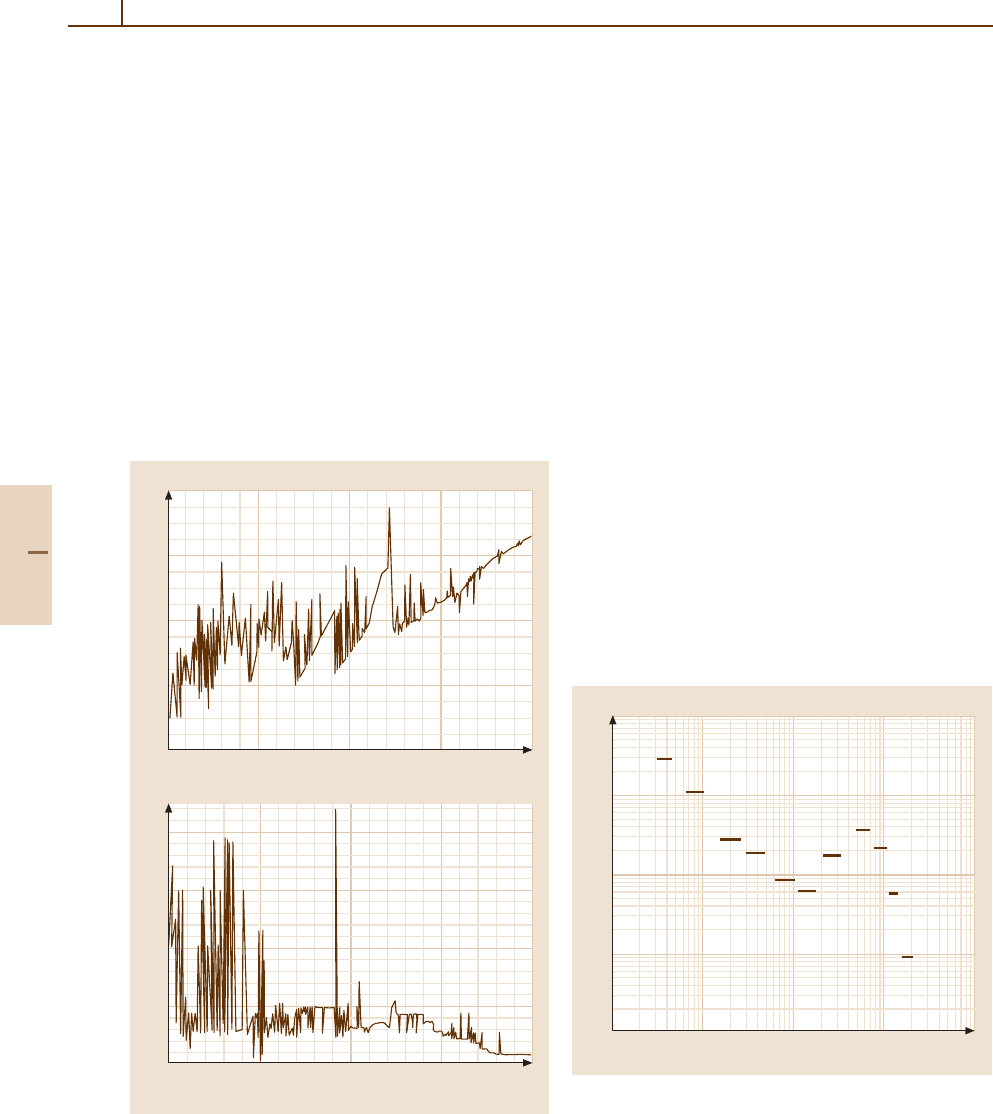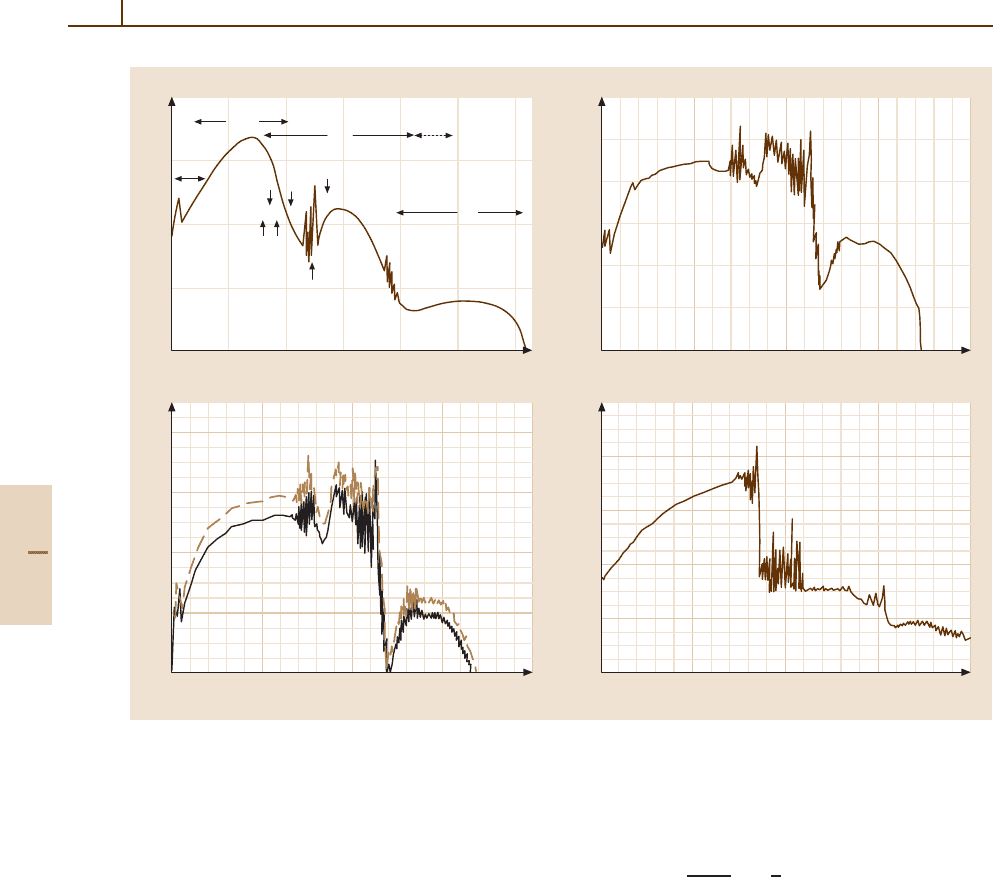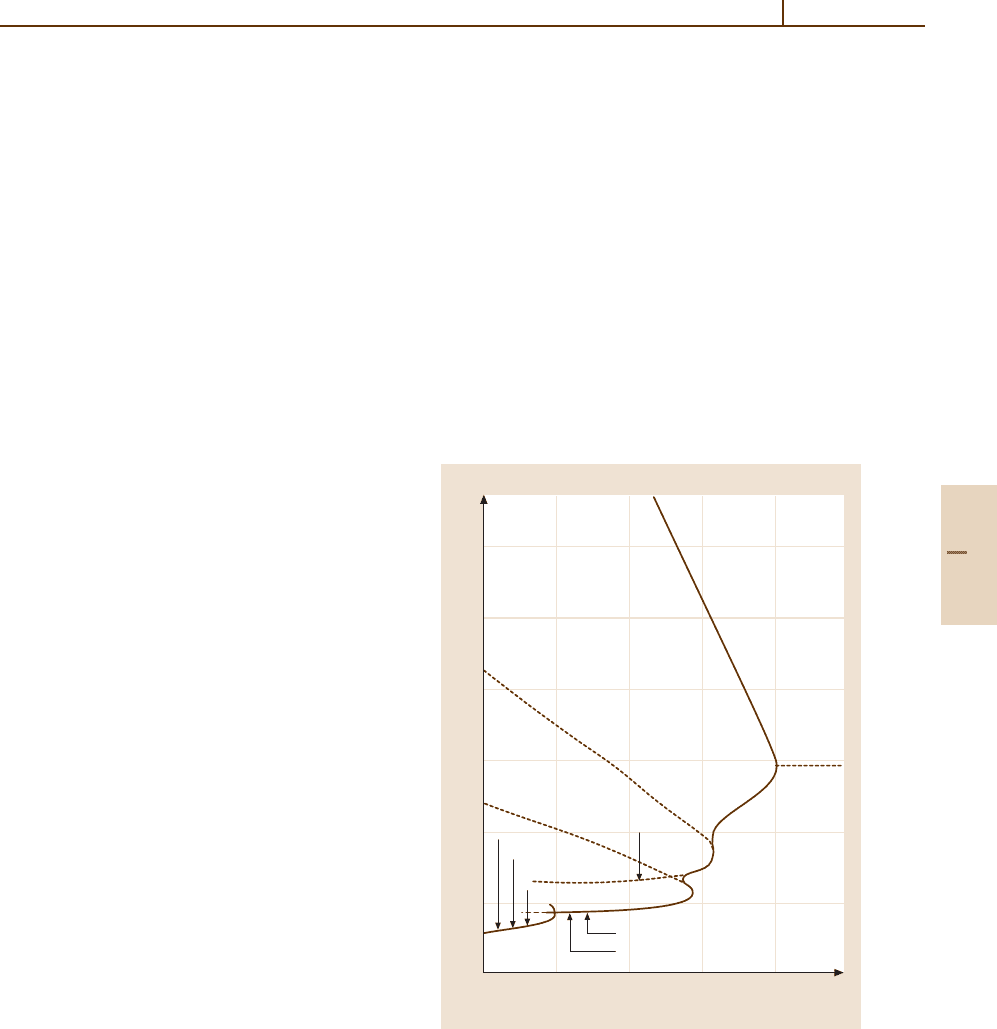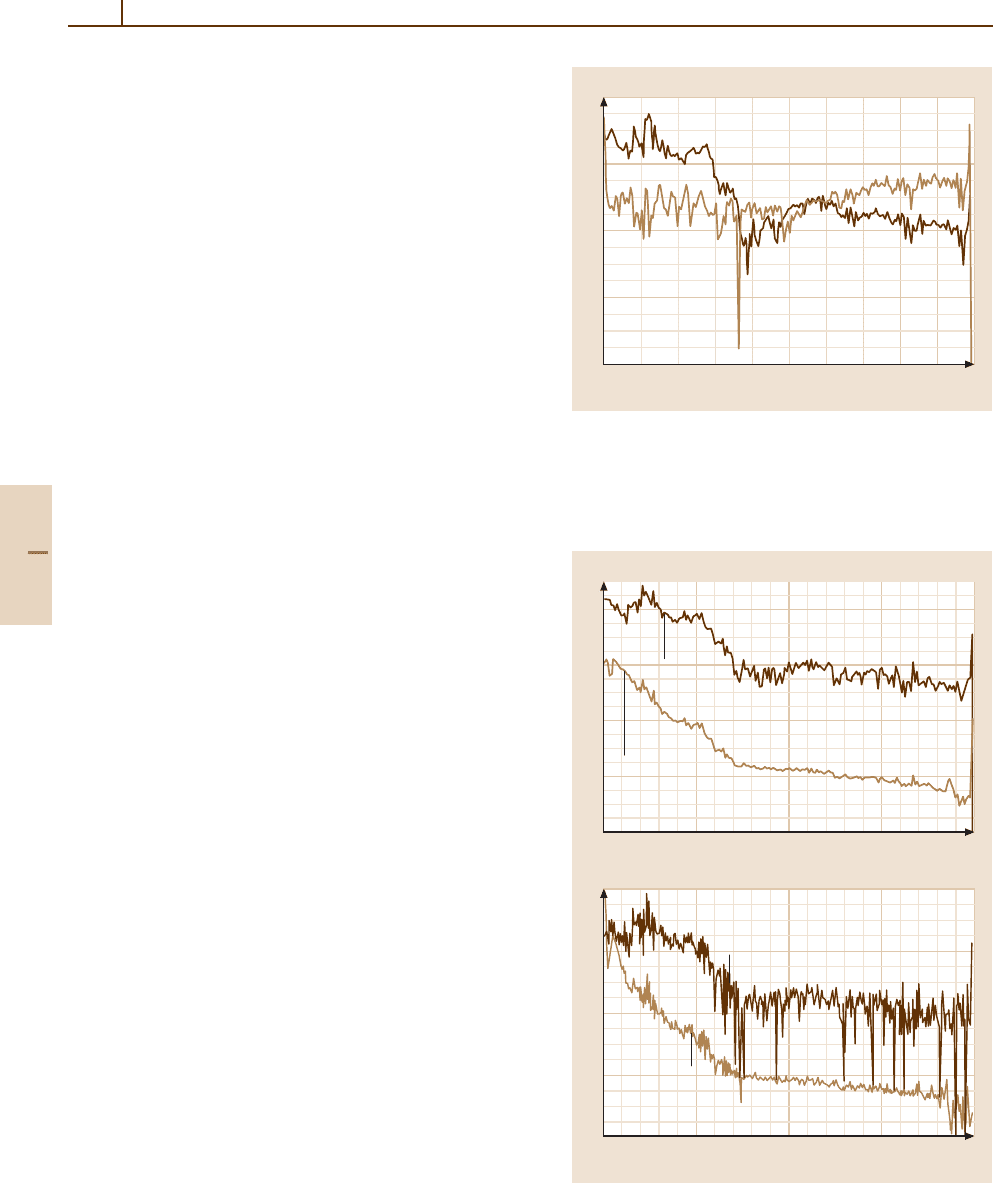Drake G.W.F. (editor) Handbook of Atomic, Molecular, and Optical Physics
Подождите немного. Документ загружается.


Aeronomy 84.1 Basic Structure of Atmospheres 1263
Table 84.4 Composition of the lower atmospheres of
Jupiter and Saturn
Species Mixing Ratio
Jupiter Saturn
H
2
0.864
b
0.94
a
He 0.136
b
0.06
a
CH
4
0.001 81
b
0.0045
a
NH
3
< 0.002
b
(0.5–0.2 ppm
c
)
H
2
O 520 ppm
b
C
2
H
6
5 ppm
a
7.0 ppm
c
PH
3
0.6 ppm
a
1.4 ppm
c
C
2
H
2
0.02 ppm
a
0.3 ppm
c
20
Ne ≤ 26 ppm
b
36
Ar ≤ 9 ppm
b
84
Kr ≤ 3.2 ppb
b
132
Xe ≤ 0.38 ppb
b
a
After Strobel [84.25]
b
After Niemann et al. [84.26]
c
After Lodders and Fegley [84.27]
probably about 600 K. Because the Voyager data have
not been fully analyzed, the value of T
∞
is uncer-
tain [84.12]. The compositions of the lower atmospheres
of Uranus and Neptune are given in Table 84.5.
Titan, which is a satellite of Saturn, has an N
2
/CH
4
atmosphere of intermediate oxidation state. The mix-
ing ratios of components of the lower atmosphere are
giveninTable84.6. The surface P and T are 1.496 bar
and 94 K, respectively. T decreases above the surface
to about 71 K at the tropopause, which occurs at an
altitude of 42 km and a pressure of 128 mbar. A re-
Table 84.5 Composition of the lower atmospheres of
Uranus and Neptune
a
Species Mixing Ratio
Uranus Neptune
H
2
≈ 0.825 ≈ 0.80
He ≈ 0.152 ≈ 0.19
CH
4
≈ 0.023 ≈ 0.01–0.02
HD ≈ 148 ppm ≈ 192 ppm
CH
3
D ≈ 8.3 ppm ≈ 12 ppm
C
2
H
6
≈ 1–20 ppb ≈ 1.5 ppm
C
2
H
2
≈ 10 ppb ≈ 60 ppb
CO < 40 ppb 2.7 ±1.8 ppm
b
NH
3
< 100 ppb < 600 ppb
H
2
O 5–12 ppb 1.5–3.5 ppb
a
After Lodders and Fegley [84.27], except as noted
b
Courtin et al. [84.28]
Table 84.6 Composition of the lower atmosphere of Titan
a
Species Mixing Ratio
N
2
0.90–0.98
CH
4
0.01–0.03
b
H
2
2.0×10
−3
CO 60–150 ppm
C
2
H
6
20 ppm
C
3
H
8
4 ppm
C
2
H
2
2 ppm
C
2
H
4
0.4 ppm
HCN 0.2 ppm
Titan’s atmosphere may also contain up to 14% Ar [84.10]
a
From [84.29], except as noted
b
From [84.9]
analysis of the Voyager 1 solar occultation experiment
showed that, above the tropopause, the temperature in-
creases to a peak value of about 176 K at an altitude of
about 300 km. The temperature then decreases to a T
∞
of 153–158 K [84.9]
Triton is a satellite of Neptune. It also has an N
2
at-
mosphere with small amounts of methane, CO, H
2
,and
other species. The mixing ratios at 10 km are given in Ta-
ble 84.7. The surface P is about 14–19 µbar. Methane in
the troposphere is in equilibrium with a surface methane
frost at about 38–50 K. The tropopause temperature is
about 36 K, and occurs in the 8 to 12 km region. The
middle atmosphere is isothermal with a temperture of
about 52 K from 25 to 50 km, increasing to 78 K near
150 km [84.30]. T rises to an T
∞
of about 100 K.
Io and Europa are satellites of Jupiter. Both have
transient atmospheres, with mean lifetimes of 2–3 days.
The radius of Io is about 1821 km, and its atmosphere is
Table 84.7 Composition of the atmosphere of Triton
a
Species Mixing Ratio Comments
N
2
0.99 ± 0.01 Below ≈ 200 km
CO 0.0001–0.01 Uncertain
CH
4
113 ppm
H
2
75 ppm
N 3.8×10
−5
ppm
N 290 ppm 100 km (near peak)
H 0.092 ppm
H 1 ppm 30 km (near peak)
C
2
H
4
3.9×10
−4
ppm
C
2
H
4
2.9×10
−2
ppm 26 km (near peak)
a
From [84.15]. Values are at 10 km, except as noted
Part G 84.1

1264 Part G Applications
mostly SO
2
, which is produced by volcanic plumes. One
model predicts that the average column density of SO
2
is
about 10
16
cm
−3
, and is larger at the equator than at the
poles [84.31]. The atmospheric temperatures range from
100 to 2000 K, and the exospheric temperature is about
1800 K. The altitude of the exobase is about 1400 km.
A plot of the number density and temperature as a func-
tion of altitude is shown in Figure 80–9 k. Europa is
characterized by a radius of 1596 km. The atmosphere
is mostly O
2
with column density of 5 × 10
14
cm
−2
and
a scale height of 145 km. The O
2
is produced by sput-
tering of the ice-covered surface, and is removed in
sputtering by torus thermal ions [84.32]. The ionosphere
is produced by impact of electrons in Jupiter’s magneto-
sphere, and the maximum density of electrons is about
4×10
4
cm
−3
[84.33].
Mercury does not have a troposphere, mesosphere,
or stratosphere; The pressure at the surface is on the
order of a picobar; thus the surface of the planet is the
exobase. Nevertheless, several atomic species have been
identified in fluorescence. They are listed in Table 84.8.
Among the possible sources of atmospheric species are
evaporation, ion sputtering, meteoroid bombardment,
and photon-stimulated desorption. Ions produced by
photoionization of neutrals may be picked up by the
solar wind and lost from the atmosphere.
Pluto and its satellite Charon form what is sometimes
referred to as a double planet system. The radius of
Table 84.8 Number densities of species at the surface of
Mercury
a
Species Number density (cm
−3
)
H 230
hot H 23
He 6×10
3
O < 4.4×10
4
Na
b
(1.7–3.8) × 10
4
K
b
5×10
2
a
from Hunten et al. [84.34]
b
Variable spatially and temporally
Pluto is 1150–1200 km, and that of Charon is about
600 km. The atmosphere of Pluto is mostly N
2
, with
small amounts of methane, CO, H
2
, and H. Only upper
limits are available for the mixing ratio of CO. The
surface pressure and temperature are in the ranges 1
to 10 µbar and 35 to 57 K, respectively. Although the
pressure at the surface is approximately the same as
that of the base of the thermosphere on most planets,
the thermal structure of the atmosphere is influenced
by the large thermal escape flux at the top of the at-
mosphere and by adiabatic cooling. T maximizes near
1200–1260 km radius at about 100 K due to absorption
of solar UV radiation. Above that radius, T decreases
asymptotically to a value of about 80 K [84.35,36].
84.2 Density Distributions of Neutral Species
84.2.1 The Continuity Equation
The density distribution of a minor neutral species j in
an atmosphere is determined by the continuity equation:
∂n
j
∂t
+∇· Φ
j
= P
j
−L
j
, (84.7)
where Φ
j
is the flux of species j,andP
j
and L
j
are
the chemical production and loss rates, respectively. If
only the vertical direction is considered, the divergence
of the flux becomes ∂Φ
j
/∂z,andΦ
j
= n
j
w
j
,where
w
j
is the vertical velocity of the species and n
j
is its
number density. In one-dimensional models, transport
due to turbulence and other macroscopic motions of air
masses is often parametrized like molecular diffusion,
using an eddy diffusion coefficient K in place of the
molecular diffusion coefficient D
j
. The total transport
velocity w
j
is then the sum of the diffusion velocity w
D
j
and the eddy diffusion velocity w
K
j
:
w
j
= w
D
j
+w
K
j
. (84.8)
If there are no net flows of major constituents, w
D
j
and
w
K
j
satisfy the equations
w
D
j
=−D
j
1
n
j
dn
j
dz
+
1
H
j
+
(1+α
T
j
)
T
dT
dz
,
(84.9)
w
K
j
=−K
1
n
j
dn
j
dz
+
1
H
avg
+
1
T
dT
dz
.
(84.10)
In these expressions, α
T
j
is the thermal diffusion fac-
tor (the ratio of the thermal diffusion coefficient to the
molecular diffusion coefficient), and the pressure scale
height H
avg
for a mixed atmosphere is given by (84.5)
with m = m
avg
, the average molecular mass.
Part G 84.2

Aeronomy 84.3 Interaction of Solar Radiation with the Atmosphere 1265
For a stationary atmosphere, if molecular diffusion
greatly exceeds eddy diffusion and if photochemistry
can be neglected, then w
D
j
= 0. The resulting number
density distribution is called diffusive equilibrium, and
is given by
n
j
(z) = n
j
(z
0
)
T
0
T
1+α
T
j
exp
−
z
z
0
dz
H
i
.
(84.11)
When mixing processes dominate and w
K
j
= 0, the dis-
tribution is given by (84.6), with H = H
avg
.
84.2.2 Diffusion Coefficients
In the thermosphere of a planet, above the homopause,
the major transport mechanism is diffusion, or trans-
port by random molecular motions. The characteristic
time τ
D
for molecular diffusion is approximately
H
2
j
/D
j
. The diffusion coefficient for a species j in
a multicomponent mixture is usually taken as a weighted
mean of binary diffusion coefficients D
jk
1
D
j
=
k=j
f
k
D
jk
, (84.12)
where f
k
is the mixing ratio of species k. The binary
diffusion coefficient can be expressed as
D
jk
=
3k
B
T
16n
t
µ
jk
Ω
jk
, (84.13)
where µ
jk
is the reduced mass
µ
jk
=
m
j
m
k
m
j
+m
k
(84.14)
and n
t
= n
j
+n
k
is the total number density. The colli-
sion integral Ω
jk
is given by
Ω
jk
=
1
2π
1/2
µ
2k
B
T
5/2
×
∞
0
Q
D
(v)v
5
exp
−µv
2
/2k
B
T
dv
(84.15)
where v is the relative velocity of the particles, Q
D
(v)
is the diffusion or momentum transfer cross section
Q
D
(v) = 2π
π
0
σ
el
jk
(θ, v)(1 −cos θ) sin θ dθ,
(84.16)
and σ
el
jk
(θ, v) is the differential cross section for elas-
tic scattering of species j and k through angle θ.In
practice, D
jk
is often expressed as b
jk
/n
t
where n
t
is
the total number density and b
jk
is the binary colli-
sion parameter, which is usually given in tabulations
in the semi-empirical form b = AT
s
.HereA and s
(0.5 ≤s ≤ 1.0) are parameters that are fit to the data.
The binary collision parameter appears, for example, in
the expression for the diffusion limited flux of a light
species to the exobase of a planet (Sect. 84.7).
84.3 Interaction of Solar Radiation with the Atmosphere
84.3.1 Introduction
The source for all atmospheric processes is ultimately
the interaction of solar radiation, either photons or par-
ticles, with atmospheric gases. Since visible photons
arise from the photosphere of the sun, which is character-
ized by T ≈ 6000 K, the solar spectrum in the visible and
IR is similar to that of a black body at 6000 K. At longer
(radio) and shorter (UV and X-ray) wavelengths, the
photons arise from parts of the chromosphere and corona
where the temperatures are higher (10
4
to 10
6
K). Thus
the photon fluxes differ substantially from those which
would be predicted for a 6000 K black body. Photons
in the extreme and far UV regions of the spectrum are
absorbed in the terrestrial thermosphere and X-rays in
the lower thermosphere and mesosphere. The solar Ly-
man α line at 1216 Å penetrates through a window in
the O
2
absorption cross sections to about 75 km. Near
UV photons are absorbed by ozone in the stratosphere,
and visible radiation is not appreciably attenuated by the
atmosphere.
The wavelength ranges that are most important for
aeronomy are the UV and X-ray regions. A solar spec-
trum in the UV and soft X-ray regions at low solar
activity is presented in Fig. 84.2a, and the ratio of a high
solar activity photon fluxes to those at low solar ac-
tivity is shown in Fig. 84.2b. The ratio is near unity
at wavelengths longward of 2000 Å, but increases to
factors that range between 2 and 3 over much of the
extreme UV. At wavelengths between about 100 and
Part G 84.3

1266 Part G Applications
550 Å, the ratio of high to low solar activity fluxes
reaches values as high as 100. The fluxes at X-ray
wavelengths arise principally from solar flares and can
increase by orders of magnitude from low to high solar
activity.
The sun also emits a stream of charged particles,
the solar wind, which flows radially outward in all
directions, and consists mostly of protons, electrons,
and alpha particles. The average number density of
solar wind protons is about 5 cm
−3
, and the average
speed is about 400–450 km/s at Earth orbit (1 AU). The
interaction of these particles with the magnetic field (ei-
ther induced or intrinsic) of a planet, and ultimately
with the atmosphere, is the source of auroral activity.
Terrestrial auroras arise mostly from precipitation of
electrons with energies in the kilovolt range, although
measured spectra vary widely. An example of a pri-
0 500 1000 1500 2000
6
4
2
0
–2
2
1.5
1
0.5
0
0 500 1000 1500 2000
Wavelength (Å)
log photon flux (10
6
cm
–2
Å
–1
)
a)
log F
hi
/F
low
b)
Fig. 84.2 (a) Solarspectrumat1AU for 18–2000 Å.
(b) Ratio of the flux at high solar activity to low solar
activity. Plotted with data from Tobiska [84.37]
mary electron auroral spectrum is shown in Fig. 84.3.
Terrestrial auroral emissions maximize in the midnight
sector, but dayside cusp auroras are produced by lower
energy electrons, and diffuse proton auroras are also
observed.
Since charged particles are constrained to move
along magnetic field lines, for planets with intrinsic
magnetic fields, auroras usually occur in an oval near
the magnetic poles, where the dipole field lines en-
ter the atmosphere. For Venus, which has no intrinsic
magnetic field, auroras are seen as diffuse and vari-
able emissions on the nightside of the planet. On
Earth, low latitude auroras, which arise from heavy
particle precipitation, have also been observed. The
primary particles that are responsible for Jovian au-
rora may be heavy ions originating from its satellite
Io, protons, or electrons. Due to charge transfer, heavy
particles spend part of their lifetime as neutral species,
and their paths may then diverge from magnetic field
lines. In any case, a large fraction of the effects of
auroral precipitation is due to secondary electrons, re-
gardless of the identity of the primary particles. In
addition to producing emissions of atmospheric species
in the visible, UV and IR portions of the spectrum,
auroral particles ionize and dissociate atmospheric
species and contribute to heating the neutrals, ions and
electrons.
10
7
10
6
10
5
10
4
10
3
Flux (eV
–1
cm
–2
s
–1
) Downward flux
Energy (eV)
10
1
10
2
10
3
10
4
10
5
Fig. 84.3 Downward electron flux as a function of en-
ergy measured by electron spectrometers on board a rocket
traversing an auroral arc near Poker Flat, Alaska. Af-
ter [84.38] with kind permission from Elsevier Science Ltd.,
UK
Part G 84.3

Aeronomy 84.3 Interaction of Solar Radiation with the Atmosphere 1267
84.3.2 The Interaction of Solar Photons
with Atmospheric Gases
The number flux of solar photons in a small wavelength
interval around λ at an altitude z can, for the most part,
be computed from the Beer–Lambert absorption law
F
λ
(z) = F
∞
λ
exp[−τ(λ, z)] , (84.17)
where F
∞
λ
is the solar photon flux outside the atmos-
phere, and τ(λ, z) is the optical depth which, in the plane
parallel approximation, is given by
τ(λ, z) =
j
∞
z
n
j
(z
)σ
a
j
(λ) sec χ dz
. (84.18)
Here, σ
a
j
(λ) is the absorption cross section of species j
at wavelength λ, and the solar zenith angle χ is the angle
of the sun with respect to the local vertical.
For χ greater than about 75
◦
, the variation of the so-
lar zenith angle along the path of the radiation cannot be
neglected; the optical depth must be computed by nu-
merical integration along this path in spherical geometry.
For χ ≤ 90
◦
the optical depth is
τ(λ, z) =
j
∞
z
n
j
(z
)σ
a
j
(λ)
×
1−
r
o
+z
r
o
+z
2
sin
2
χ
−0.5
dz
.
(84.19)
For χ larger than 90
◦
, the optical depth is given by
τ(λ, z) =
j
2
∞
z
s
n
j
(z
)σ
a
j
(λ)
×
1−
r
o
+z
s
r
o
+z
2
sin
2
90
◦
−0.5
dz
−
∞
z
n
j
(z
)σ
a
j
(λ)
×
1−
r
o
+z
r
o
+z
2
sin
2
χ
−0.5
dz
,
(84.20)
where z
s
is the tangent altitude, the point at which the
solar zenith angle is 90
◦
for the path of solar radiation
through the atmosphere.
In a one-species atmosphere, the rate of absorption
of solar photons of wavelength λ is
q
a
(λ) = F
λ
σ
a
(λ)n . (84.21)
For an isothermal atmosphere in which H(z) ≈ const.,
the absorption maximizes where τ(λ, z) = 1. This is
a fairly good approximation even for regions of the
atmosphere where the H(z) is not constant. The alti-
tude of unit optical depth is shown for wavelengths
from X-rays to the near UV for overhead sun in
the terrestrial atmosphere in Fig. 84.4a. Similar plots
for Venus, Mars and Jupiter are shown in Fig. 84.4b,
Fig. 84.4c, and Fig. 84.4d, respectively. N
2
does not ab-
sorb longward of about 100 nm, so in the terrestrial
atmosphere, O
2
and O
3
are the primary absorbers be-
tween 100 and 220 nm, while ozone dominates the
absorption for wavelengths in the range 220–320 nm.
On Venus and Mars, CO
2
is the main absorber of FUV
and EUV radiation, although at wavelengths less than
about 100 nm, N
2
, CO, and O also contribute. On Titan,
methane is the primary absorber of UV radiation be-
tween 1400 Å and the absorption threshold of N
2
, near
1000 Å.
The interaction of UV photons with atmospheric
gases produces ions and photoelectrons through pho-
toionization, which may be represented as
X +hν → X
+
+e
−
, (84.22)
and photodissociative ionization
AB +hν → A
+
+ B+ e
−
. (84.23)
In these equations, X represents any atmospheric
species; A is either an atom or a molecular fragment
and AB a molecule. The energy of the photoelectron in
reaction (84.22)isgivenby
E
pe
= hν − I
X
− E
ex
(84.24)
and in reaction (84.23)is
E
pe
= hν − E
d
− I
A
− E
ex
, (84.25)
where I
j
is the ionization potential of species j, E
d
is
the dissociation energy of molecule AB,andE
ex
is the
internal excitation energy of the products. Neutral frag-
ments, which may be reactive radicals, are also produced
in photodissociation
AB +hν → A+ B . (84.26)
Part G 84.3

1268 Part G Applications
N
2
O
O
2
O
2
O
3
N
+
O
+
2
O
+
N
+
2
NO
+
Lyman α
AIR
0 50 100 150 200 300250
Altitude (km)
Wavelength (nm) Wavelength (Å)
200
150
100
50
0
160
150
140
130
120
110
100
160
140
120
100
80
1000
800
600
400
200
0
0 500 1000 1500 2000 0 500 1000 1500 2000
0 500 1000 1500 2000
Altitude (km)
Altitude (km) Altitude (km)
Wavelength (Å)Wavelength (Å)
Mars Lo
a)
b)
c)
d)
Fig. 84.4a–d The altitude where τ = 1 versus wavelength (a) Earth [84.39] (b) Venus (c) Mars [84.40] (d) Jupiter (Y. H.
Kim, unpublished)
The rate of ionization of a species j by a photon of
wavelength λ at an altitude z is given by
q
i
j
(λ, z) = F
λ
(z)σ
i
j
(λ)n
j
(z), (84.27)
where σ
i
j
(λ) is the photoionization cross section. The
rate for photodissociation is given by a similar expres-
sion, with the photoionization cross section replaced
by the photodissociation cross section. The expression
above must be integrated over the solar spectrum to give
the total rate. In addition, it is often necessary to take
into account ionization and/or dissociation to different
final internal states of the products, so the partial cross
sections or yields are needed.
In the atmospheres of magnetic planets, photoelec-
trons may travel upward along the magnetic field lines
to the conjugate point, where the field line re-enters the
atmosphere. In order to model this effect, the differential
(with respect to angle) cross sections for photoionization
σ
i
j
(λ, θ) are necessary. The differential cross section is
sometimes expressed as
σ
i
j
(λ, θ) =
σ
i
j
(λ)
4π
[1−
1
2
β(λ)P
2
(cos θ)] , (84.28)
where θ is the angle between the incident photon beam
and the ejected electron, P
2
is a Legendre polynomial,
and β is an asymmetry parameter.
84.3.3 Interaction of Energetic Electrons
with Atmospheric Gases
Suprathermal electrons, which are denoted here e
∗−
,and
include both photoelectrons and auroral primary elec-
trons, can also ionize species through electron-impact
ionization
X +e
∗−
→ X
+
+e
−
+e
−
(84.29)
Part G 84.3

Aeronomy 84.3 Interaction of Solar Radiation with the Atmosphere 1269
and electron-impact dissociative ionization
AB +e
∗−
→ A
+
+ B+e
−
+e
−
. (84.30)
In these reactions, e
−
represents the energy degraded
photoelectron or primary electron, and e
−
the secondary
electron. The energy of the secondary electron E
e
in an
electron-impact ionization process (84.29)isgivenby
E
e
= E
e*
− I
X
− E
ex
− E
e
, (84.31)
where E
e*
is the energy of the primary or photoelectron,
E
e
is the energy of the degraded primary or photoelec-
tron, and E
ex
is the internal excitation energy of the
product ions and/or neutral fragments. For the dissocia-
tive ionization process (84.30) the dissociation energy
of the molecule must also be subtracted as well.
Energetic electrons can also dissociate atmospheric
species. In this process
AB +e
∗−
→ A+ B +e
−
(84.32)
the energy of the degraded electron is
E
e
= E
e*
− D
AB
− E
ex
, (84.33)
where D
AB
is the dissociation energy of molecule AB.
Collisions with suprathermal electrons can also promote
species to excited electronic, vibrational or rotational
states:
AB +e
∗−
→ AB
†
+e
−
, (84.34)
where the dagger denotes internal excitation. The energy
lost by the electron is thus the excitation energy of the
species.
In determining the rate of ionization, dissociation
and excitation by photoelectrons, the local energy loss
approximation, that is, the assumption that the electrons
lose their energy at the same altitude where they are
produced, is fairly good near the altitude of peak photo-
electron production. The mean free path of an electron
near 150 km is about 30 m. Substantially above the alti-
tude of peak production of photoelectrons, transport of
electrons from below is important, and use of the local
energy loss assumption causes the excitation, ionization,
and dissociation rates to be underestimated. For keV au-
roral electrons, the computation of the energy deposition
of the electrons must consider their transport through the
atmosphere. Thus the elastic total and differential cross
sections for electrons colliding with neutral species must
be employed, as well as the inelastic cross sections, and
the angles through which the electrons scatter must be
taken into account.
In general, the excitation rate q
k
j
(z) of a species j
to an excited level k with a threshold energy E
k
at an
altitude z by electron impact is given by:
q
k
j
(z) = n
j
(z)
∞
E
k
σ
k
j
(E)
dF(z, E)
dE
dE ,
(84.35)
where σ
k
j
(E) is the excitation cross section at elec-
tron energy E,anddF(z, E)/dE is the differential flux
of electrons (between energies E and E + dE). The ion-
ization rate q
i
j
(z) of a species with ionization potential I
j
due to electron impact is given by
q
i
j
(z)
= n
j
(z)
∞
I
j
(E−I
j
)/2
0
dσ
i
j
(E)
dW
s
dF(z, E)
dE
dW
s
dE ,
(84.36)
where dσ
i
j
(E)/ dW
s
is the differential cross section for
production of a secondary electron with energy W
s
by
a primary electron with energy E. The integral over
secondary energies W
s
terminates at (E−I
j
)/2 because
the secondary electron is by convention considered to
be the one with the smaller energy. Since the average
energy of photoelectrons is less than 20 eV, the error
incurred in cutting off the integrals in equations (84.35)
and (84.36) at 200 eV or so, rather than (E − I
j
)/2is
not serious, although for high energy auroral electrons
a larger upper limit may be required.
An estimate of the number of ionizations in a gas pro-
duced by a primary electron with energy E
p
is E
p
/W
ip
,
where W
ip
is the energy loss per ion pair produced,
which approaches a constant value as the energy of
the electron increases. Empirical values are available
for W
ip
for many gases, and usually fall in the range
30–40 eV [84.41].
The total loss function or stopping cross section for
an electron with incident energy E in a gas j is given by
the expression
L
j
(E) =
k
σ
k
j
(E)W
k
j
+
(E−I
j
)/2
0
(I
j
+W
s
)
dσ
i
j
(E)
dW
s
dW
s
,
(84.37)
where W
k
j
is the energy loss associated with excitation
of species j to excited state k. The differential cross
Part G 84.3

1270 Part G Applications
section is usually adopted from an empirical formula
that is normalized so that
σ
i
j
(E) =
(E−I
j
)/2
0
dσ
i
j
(E)
dW
s
dW
s
, (84.38)
where σ
i
j
(E) is the total ionization cross section at pri-
mary electron energy E. One formula in common use is
that employed by Opal et al. [84.42]tofittotheirdata:
dσ
i
j
(E)
dW
s
=
A(E)
1+
W
s
/W
2.1
, (84.39)
where A(E) is a normalization factor and W is an em-
pirically determined constant, which has been found to
be equal to within a factor of about 50% to the ionization
potential for a number of species.
For energy loss due to elastic scattering by thermal
electrons, an analytic form of the loss function such as
that proposed by Swartz et al. [84.43] may be used:
L
e
(E) =
3.37×10
−12
E
0.94
n
0.03
e
E −k
B
T
e
E −0.53k
B
T
e
2.36
,
(84.40)
where T
e
is the electron temperature and n
e
is the number
density of ambient thermal electrons.
For high energy auroral electrons, the rate of energy
loss per electron per unit distance over the path s of the
electrons in the atmosphere can be estimated using the
continuous slowing down approximation (CSDA)as
−
dE
ds
=
j
n
j
(z)L
j
(E) sec θ +n
e
(z)L
e
(E) sec θ,
(84.41)
where θ is the angle between the path of the primary
electron s and the local vertical. In the CSDA, all the
electrons of a given energy are assumed to lose their
energy continuously and at the same rate. The rate of
energy loss (−dE/ ds) is integrated numerically over
the path of the electron, which degrades in energy un-
til it is thermalized. In this approximation, inelastic
processes are assumed always to scatter the electrons
forward, so cross sections that are differential in angle
are not required. Because electrons actually lose energy
at different rates, however, and because elastic and in-
elastic scattering processes do change the direction of
the electrons, the CSDA gives an estimate for the rates
of electron energy loss processes that is increasingly
inaccurate as the energy of the electron decreases.
In practice, discrete energy loss of electrons can
be easily treated numerically if the local energy loss
approximation is valid. The spectrum of electrons is di-
vided into energy bins that are smaller than the energy
losses for the processes, and the integrals in (84.35, 36)
are replaced by sums over energy bins. Since elastic
scattering of electrons by neutrals changes mostly the
direction of the incident electron, and not its energy,
only inelastic processes need be considered. In order to
compute excitation and dissociation rates, only integral
cross sections are required; the scattering angle is unim-
portant. For ionization, of course, the energy distribution
of the secondary electrons must be considered, but not
the scattering angles of either the primary or secondary
electrons. Below the lowest thresholds for excitations,
energetic electrons lose their energy in elastic collisions
with thermal electrons. The process of energy loss to
thermal electrons is often approximated as continuous,
rather than discrete.
The collision frequency ν
k
j
for a discrete electron-
impact excitation process k of a species j is given by
ν
k
j
(E) = n
j
(z)v
e
(E)σ
k
j
(E). (84.42)
For energy loss due to elastic scattering from ther-
mal electrons, a pseudo-collision frequency ν
e
may be
defined as
ν
e
(E) =
1
∆E
−
dE
dt
,
(84.43)
where ∆E is the grid spacing in the calculation, and the
energy loss rate is
−
dE
dt
= v
e
(E)n
e
L
e
(E), (84.44)
where L
e
is taken from (84.40).
Since the energy bins should be smaller than the
typical energy loss in order to obtain accurate rates for
the excitation processes, it is often convenient to treat
rotational excitation also as a continuous process, with
a pseudo-collision frequency similar to that for elastic
scattering from ambient electrons (84.43) with
−
dE
dt
= v
e
(E)n
j
L
rot
j
(E), (84.45)
where the loss function for rotational excitation is given
by
L
rot
j
(E) =
J
η
J
j
J
σ
J,J
j
(E)W
J,J
j
. (84.46)
In this expression, η
J
j
is the fraction of molecules
jmeasured or computed cross section for electron-
impact excitation of species j from rotational state J
to rotational state J
,andW
J,J
j
is the associated energy
loss.
Part G 84.3

Aeronomy 84.4 Ionospheres 1271
The slowing down of high energy auroral primary
electrons or photoelectrons arises from both elastic and
inelastic scattering processes, and cannot be treated us-
ing the local energy loss approximation. In solving the
equations for electron transport, theangle through which
the primary electron is scattered, as well as the change in
energy of the primary electron and the production of any
secondaries, must be taken into account. Thus differen-
tial cross sections for the elastic and inelastic scattering
of electrons by neutral species are required. The detailed
equations for electron transport have been presented by,
for example, Rees [84.44].
Several methods for approximating the energy de-
position of auroral electrons are currently in use. The
CSDA has already been discussed, but it provides
only a rough approximation to the depth of penetra-
tion of the electrons, and the rates of excitation, ion
production, and other energy loss processes. In the
two-stream approximation, the electrons are assumed
to be scattered in either the forward or backward di-
rection [84.45]. Implementation of this method requires
only the backscattering probabilities, rather than com-
plete differential cross sections. The method has been
generalized to multi-stream models, in which the solid
angle range of the electrons is divided into 20 or more
intervals, so more or less complete differential cross sec-
tions are required [84.46,47]. Monte Carlo methods have
also been used to model auroral precipitation [84.48].
84.4 Ionospheres
84.4.1 Ionospheric Regions
The division of the ionosphere into regions is based
on the structure of the terrestrial ionosphere, which
consists of overlapping layers of ions. These layers
are the result of changes both in the composition of
the thermosphere and in the sources of the ioniza-
tion, and are shown schematically in Fig. 84.5.The
major molecular ion layer is the F
1
layer, which is
produced by absorption of EUV (100–1000 Å) pho-
tons by the major thermospheric species, and occurs
where the ion production maximizes. The E layer is
below the F
1
layer and is produced by shorter and
longer wavelength photons that are absorbed deeper
in the atmosphere: soft X-rays and Lyman β,which
can ionize O
2
and NO (Fig. 84.4a). In the D region,
the densities of negative ions ecome appreciable and
large densities of positive cluster ions appear. These
ions are produced by harder X-rays, with λ
10 Å, and
Lyman α, which penetrates to about 75 km, where it
ionizes NO. The highest altitude peak in the terres-
trial ionosphere is the F
2
peak, which occurs near or
slightly below 300 km, where the major ion is O
+
.The
peak density occurs where the chemical lifetime of the
ion is equal to the characteristic time for transport by
diffusion (∼ H
2
/D).
84.4.2 Sources of Ionization
As discussed in Sect. 84.3, ionization can be pro-
duced either by solar photons and photoelectrons during
the daytime or by energetic particles and secondary
electrons during auroral events. Photoelectrons have suf-
600
500
400
300
200
100
10
2
10
3
10
4
10
5
10
6
Electron density (cm
–3
)
Altitude (km)
Topside
ionosphere
Bottomside
ionosphere
X
+
XY
–
XY
+
F
2
F
1
E
EUV
UV Lyβ 1026Å
Lyα 1216Å
X-Rays (10–100Å)
X-Rays <10Å
Cosmic rays
D
Fig. 84.5 Ionospheric regions and primary ionization
sources. After Bauer [84.49]
ficient energy to carry out further ionization if they are
produced by photons with λ
500 Å. These photons
penetrate further and exhibit larger solar activity vari-
ations than longer-wavelength ionizing photons. Thus
Part G 84.4

1272 Part G Applications
the ionization rate due to photoelectrons peaks below
the main photoionization peak. Primary flux spectra of
photoelectrons produced near the F
1
peak (172 km) and
below the ion peak (100 km) are shown in Fig. 84.6.The
primary spectrum at the ion peak consists mostly of low
energy electrons, whereas at 100 km, the low energy pri-
maries are depleted, and there are relatively larger fluxes
of electrons with E
50 eV. Figure 84.7 shows the pri-
mary and steady-state photoelectron spectra near the ion
peaks on Venus and Titan.
The major ions produced in the ionospheres of the
earth and planets are usually those from the major
thermospheric species: N
+
2
,O
+
2
,andO
+
on Earth; CO
+
2
,
O
+
,N
+
2
,andCO
+
on Venus and Mars; and H
+
2
,H
+
,and
He
+
on the outer planets; N
+
2
,N
+
,andCH
+
4
in the iono-
sphere of Titan, and N
+
2
,N
+
,andC
+
in the ionosphere
of Triton. In the presence of sufficient neutral densities,
however, ion–molecule reactions transform ions whose
parent neutrals have high ionization potentials to ions
whose parent neutrals have low ionization potentials.
This is a rigorous rule only for charge transfer reactions,
but it applies more often than not in other ion–molecule
reactions as well.
Because of transformations by ion–molecule reac-
tions, the major ions in the F
1
regions of the ionospheres
of Earth, Venus and Mars are O
+
2
and NO
+
, in spite of
the large differences in composition between the thermo-
sphere of the earth and the thermospheres of Venus
and Mars. A diagram illustrating the ion chemistry in
the ionospheres of the terrestrial planets is shown in
Fig. 84.8. The vertical positions of the ions in this figure
represent the relative ionization potentials of the par-
ent neutrals. In regions where there are sufficient neutral
densities the ionization flows downward.
Table 84.9 shows ionization potentials (I
P
) for sev-
eral major and minor species present in planetary
thermospheres. Major atmospheric species generally
have I
P
12–13 eV (λ<900–1000 Å). Only a few
species can be ionized by the strong solar Lyman al-
pha line (1216 Å, 10.2 eV), including NO, and a few
small hydrocarbons and radicals, such as CH
3
and C
2
H
5
.
Metal atoms, which are produced in the lower thermo-
spheres and mesospheres of planets from ablation of
meteors, have very low ionization potentials, and some
can be ionized by photons with wavelengths longer than
2000 Å.
Fig. 84.7 Computed primary and steady-state spectra for
photoelectrons near the F
1
peak on Venus at 1 eV resolution
(top), and Titan at 0.5 eV resolution (bottom). The steady-
state spectra are averaged over three intervals in both plots
10
8
6
4
2
160 180 2000 20 40 60 80 100 120 140
Energy (eV)
log electron flux (cm
–2
s
–1
eV
–1
sr
–1
)
Earth
172km
100 km
Fig. 84.6 Primary photoelectron spectrum for the terres-
trial atmosphere at 172 km (near the F
1
peak) and at 100 km.
The spectrum at 100 km is significantly harder than that at
172 km
10
8
6
4
2
Energy (eV)
0 50 100 150 200
8
6
4
2
0
Energy (eV)
0 50 100 150 200
log electron flux (cm
–2
s
–1
eV
–1
sr
–1
)
Venus 140 km
Initial
Steady-state
log electron flux (cm
–2
s
–1
eV
–1
sr
–1
)
Titan 1000 km
Initial
Steady-state
Part G 84.4
